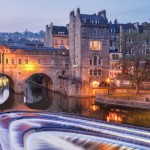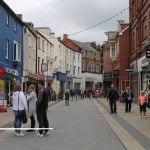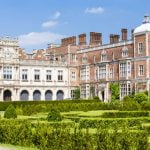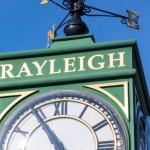
Lincoln has been around for a long time and although it no longer holds the importance of old, it remains the biggest city in Lincolnshire and a great place to visit. The city is quite well known for its Cathedral and University but for even the casual visitor there is a whole host of things to do and see, as well as a long and interesting history to explore. So why not join us for the Five Minute Spare tour and see if Lincoln is the place for your next staycation or at least a place to add to your to-visit list when in the area.
Ready? Ok let’s begin with a little Lincolnshire History.
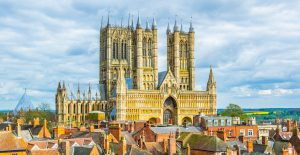
Image: trabantos/Shutterstock.com
Early Days of Lincoln
Back in 1972, scientists discovered that there were a series of round wooden hut style houses in the area, sometime during the iron age. Archaeologists actually gave their best guess at dating these to the first century. It is thought the Iron Age settlers would have survived by the fish and freshwater found in the Brayford Pool, which is where the houses were gathered. It is surmised the name of the city can be traced back to this time, since the Celtic words to describe the pool translate to Lindon.
Sometime in the 40 AD’s, the Romans decided Britain was one of the last areas of expansion for their already significant Empire. The Legionaries went on to build the first version of Lincoln castle on top of the hill here. The pool was at the bottom, presumably with a small number of native homes, with the fortress on the hillside being known as Lindum Colonia. They eventually extended the fortress all the way down the hillside towards the water.
Although not on the coast, the town of Lindum was on two rivers: the Witham and the Trent. As such, if made an ideal trading port for the Romans, who liked nothing more than a good port town to send slaves to. Lincoln became a thriving port town during this era, recorded as the Province of Flavia Caesariensis up until the third century. By the fifth century, however, it is thought that the town was largely deserted, only a shell of its former self. Romans came and went, but they built in wood, not stone. Some of the wealth of the area would have been lost.
Germanic tribes were the next to descend on this area of the country. They settled in the 5th and 6th centuries, breathing new life into the dying town. They brought Old English with them, an amalgamation of their German tongues, the Dutch brought by the Viking raiders, and the existing Celtic tongue used in Britain at the time.
The Vikings Pay A Visit
The Vikings started attacking about two centuries later, circa 800/900 AD. By this time, Lincoln was a full-on city with its own trade systems, mint, and churches. It was considered the most important town in its area, and so was made an important centre from which the Danelaw kings ran England. In 886, Lincoln was turned into one of the five main bases the Vikings used to raid from. Archaeologists have discovered a wooden town around the Flaxengate area, which would have been built around 900 to accommodate the massive new population the city received.
In a strange layout of the town, the ‘hill’ portions seemed to hold all the paperwork and council events, while the ‘pool’ area of town ended up being mostly settled by civilians. The Vikings eventually retreated, of course, but the inter-marriage with the Brits had already been happening for a few hundred years by then. It is less that they got into their boats and sailed away, and more that they assimilated themselves into the population here, in greener lands.
William the Conqueror ordered a castle built on the site of the old hill fort, around 1088. He wanted it there for the exact same reasons that the Romans had, he wanted to protect the road. 18 years after that, he ordered the Domesday Survey because he wanted to know exactly what it was that he had conquered. In the Survey, the population of the town was not recorded specifically, which often happened when settlements were so big, they were considered to be cities.
What we do know about Lincoln in 1086 is that it had three churches owned by the king, plus 103 acres of fields, 100 pounds a year worth of tenants, plough teams enough to work the fields, and the beginnings of a Cathedral which was completed in 1092. It was burned to the ground, restored, and then killed by an uncharacteristically large earthquake in the 12th century.
The Medieval Era in Lincoln
By the start of the medieval period, Lincoln had already had quite an interesting history. In an interesting turn of events, the beauty and grandeur of the cathedral in Lincoln (which has since been rebuilt again) meant that it was one of the largest dioceses in Europe. There were monasteries everywhere. One of the Bishops of Lincoln was present at the signing of the Magna Carta – that’s how important it was.
In 1141, King Stephen and Empress Matilda had a battle in the streets of Lincoln, with Stephen eventually being captured. In 1130, a guild for weavers was set up in town and it spent the next few hundred years producing textiles, as well as being an important centre of religion until Henry VIII got his hands on it. The red and green fabrics known as ‘Lincoln Green’ were always sported by Robin Hood when he appeared in tales.
In the next two hundred years or so, three new churches were erected in the town. 1190 saw anti-Semitic riots in Norfolk spread here, with some of the Jews in town being the victims of hate crime. In 1290 they were eventually turned out of the town altogether, but not before 19 of them had been sent to the Tower of London for the supposed murder of a young catholic boy.
in the 13th century, Lincoln was considered to be the third most important UK city. This was the time of the Baron’s Wars, during which the French were defeated within the city itself. The town was pillaged for being on the wrong side. Later, the war was repeated in 1266, when disgruntled rebels attacked the Jews.
In the fourteenth century, the town was made into a county borough. It is widely believed that it started to decline in importance around then, but the final nail in that particular coffin wouldn’t have come until the 16th century when Henry VIII closed down most of the churches. Before that, it was the frontier during the English Civil War, with Parliamentarians and Royalists fighting in the streets.
Lincoln, it seems, has more than a few ghosts roaming the town. The city was damaged excessively with all the fighting going on. It did pick up a little in the Georgian period, but it has never quite been the same as it was back in its heyday. Maybe it never will be again.
And on that note, let’s pause and have some fun.
Fun Facts about Lincoln, England
Every town, city, settlement, village, and single house, that we review, has some fun behind the scenes. Lincoln is no exception. With such a long, varied history, we were rubbing our hands together at these trivia titbits…
- When it was rebuilt the first time, the spires of the Cathedral in Lincoln made it the tallest building in Europe.
- The Romans built the Fosse Dyke Canal, which helped greatly to transport materials to and from the town throughout the years. It is believed to be the oldest working canal in England.
- Lincoln was the centre of the Agricultural Revolution, rather than the Industrial Revolution, which spared it a lot of the damage of northern towns.
- Lincoln didn’t have a clean, safe, pumped water supply until just before the First World War. The size of it in the past, coupled with Henry VIII closing down all the religious centres, meant that they were kind of missed out when it came to piping.
These are just a handful of the fun facts to come out of Lincoln. There are all sorts of things going on here, all the time. So you will never be short of interesting things when you are visiting. In our opinion, it is these interesting facts that make Lincoln such a prominent staycation destination in the upcoming year.
The Agricultural Revolution in Lincoln
But let’s get back to the history! There were many inventions here that made the Agricultural Revolution happen in the 18th century, even when all other towns were building up chimneys and churning out coal. The railway arrived in the early 19th century, one of the first lines to be built out of London. Lincoln experienced a population boom spurred on by many successful companies springing up. William Foster’s was one of the most notable, who went on to build the first-ever tanks made in Britain, during the First World War.
In the 19th century, sewers and streetlights were added – first gas, and then electric. Trams arrived, only to be replaced by buses. Instead of being a victim of the Industrial era, they made the heavy machinery that ploughed the fields, they made harvesting machinery and the wheels and cogs that powered the factories.
Halfway through the century, the barracks were built outside of Lincoln for the first time. They remained there all the way up until the present day, being a source of reassurance and protection to the local populace through two World Wars.
In 1904 and 1905, Lincoln suffered an outbreak of Typhoid. Every city in the country had suffered similar outbreaks, going all the way back to the Black Plague in the 14th century… but this was prominent because it happened so recently, in comparative terms. By the 20th century, almost everyone had piped water and plumbing… but outdoor toilets were still a thing and they still had the capability to contaminate the water supply. A water tower was added, but this period did nothing for the belief that you can’t drink tap water south of Sheffield.
The Modern Era
The 20th century got off to a bad start but was quickly followed by the moving of the slum housing to council estates. The First World War hit, with Lincoln going into full swing production as weapons and arms manufacturers. They primarily built tanks, aircraft parts, weapons, and munitions here. Diesel engines for trains and ships were produced in Lincoln, who experienced a mini-spurt in industrialisation during that period. Turbines have been the main product since then, eventually turning into energy supplying for much of the county. To this day, gas turbines are the biggest employer in town.
The First and Second World Wars saw different types of problem for the city. The First saw many young men lose their life during the buddy regiment scheme. This silly idea saw thousands of young men from the same area sent abroad to fight in the trenches together. After this, the government learned to mix up the army so that large areas of the country back home weren’t left without any men.
The Second World War saw Lincoln bombed significantly. In 1941, so many bombs hit the area that the whole of Westwick Gardens was impacted. One eye-witness account saw bombs going off in the front and back gardens, with the Germans even dropping a landmine which took the whole front of their house. You can read more war stories courtesy of the BBC.
Since the wars ended, The University has expanded, and the town has settled to a thriving retail and engineering-based town. It is an educated place, that still has a strong religious feel to it. We can’t wait to see what’s next for this hearty town, given all that it has already gone through… We can only hope that it doesn’t include any more tragedy in future.
Famous People from Lincoln
After all that doom and gloom, let’s see if we can’t add some magic back into the mix again. Here are the Five Minutes Spare favourite famous folk to have come from Lincoln:
- About five hundred lords/ladies/noble people that they somehow still count as famous but that you and I have never heard of.
- Jennifer Saunders was a Lincoln lass.
- Beverley Allitt, the infamous serial killer who preyed on children at the Grantham and Kesteven Hospital.
- David Cameron’s wife… OK, so far, they don’t have a great track record…
- Robert Webb, the comedian, is a bit more like it.
- As is Abi Titmuss…
- Guy Martin is from Lincoln… and countless others. From footballers to YouTube personalities, Lincoln has them all.
Honestly! We’re not even kidding. There are so many famous people from Lincoln that Wikipedia had to split the list into far past, middle past, past, and present.
Things to do in Lincoln
With so much history and a higher chance of walking into someone famous in Lincoln than in almost any other UK city; it is no wonder that this place is packed with things to see and do. Here is your guide to what to see and do in Lincoln, if you have five minutes to spare on your staycation.
Historic Sights and Landmarks
We can’t talk about Lincoln and not mention the stunning magnificence of the Cathedral. It is both historic sight and landmark, as it towers over most of the city. Joined as the only building in town with grandeur good enough to rival it, is the castle on the hilltop. The Cathedral is still in operation, while the Castle is no longer used to guard the road from bandits… but it does make a good deterrent.
Lincoln Castle is home to an original copy of the 1215 Magna Carta, brought back by the bishop that was present for the signing. It is an open castle, where you can book tickets and go to learn about both power and punishment. At one time, the castle would have housed criminals. The walls of those dungeons have seen some stuff.
If you want to get out of town for a bit, you can visit Doddington Hall and Gardens to get a taste of how the other half used to live. This beautiful Elizabethan manor house now hosts weddings, gets dressed up during the festive season, and is routinely open for visitors.
Outdoor Attractions
There are several outdoor areas you can visit for any fine summer day spent in Lincoln. One of the places at the top of the list ought to be Hartsholme Country Park. This gorgeous space has a pond with ducks and swans, plenty of picnic grass, some benches, and some swings… basically all you need to keep those kids happy on a hot day. They have about 200 acres just south of the city so do try not to get lost.
For those that like their landscapes less tame, check out the Whisby Nature Park, instead. This one has a less touristy vibe to it and sports some fantastic bird species diversity. It is run by Lincolnshire Wildlife Trust.
Museums and Galleries
One of the top three attractions in town that everyone raves about is the Museum of Lincolnshire Life. If there is anything you want to know about the city, you will find it recorded here. You could spend whole afternoons here, just learning about the past lives of those that came before you.
Although not technically a museum or a gallery, the army and navy have quite a few attractions in the area, all with a remembrance theme. Go along to the International Bomber Command Centre to experience the story of warplanes through the ages. You can also visit the RAF Scampton Heritage Centre for an in-depth take on all types of planes, and not just those that kill people. As if that wasn’t enough, you can also visit the RAF Wickenby Memorial Museum… so you really do have your pick.
There is a third option for museums in Lincoln, and that is in the Collection Museum. They have all sorts of collections, and they include the Usher Gallery on their lists. Hop along and check it out if you can, it is worth it for all the fine art.
Shopping and Retail
There is a lovely little old street in the city which is simply called ‘Steep Hill’. Can you guess why? It is England’s fourth steepest urban hill… and it sports some of the best shopping in town. Presumably, you are too busy going in and out of the shops to notice how steep it is.
Other Notable Attractions in Lincoln
As usual, Lincoln has so many attractions that we can’t possibly fit them all in. Here are some of the other best bits of Lincoln that we couldn’t detail above:
- Visit Lincoln FC or Lincoln United FC at their respective stadiums for a game or a tour.
- Stop by the guildhall for Instagram opportunities, or the Drill Hall, or any number of the others in town.
- Check out the Lincolnshire Road Transport Museum…
- … Or the new Theatre Royal…
There are a hundred places to explore in ancient Lincoln – so get out there and get to it!
How do you get there?
Now you know everything we do about Lincoln (England) that we do – except how to get there. As usual, Five Minutes Spare has got you covered.
By Road
Follow the M1 till it hits the A1, or just head east out of Sheffield.
By Rail
Lincoln Train Station is on the Northern rail line.
By Air
Robin Hood Airport in Doncaster is about 30 miles away.
By Sea
Lincoln has no access to the sea but if you can sail the River Witham, you can get there by boat.
Got Five Minutes?
Here at Five Minutes Spare, we are delighted to be able to offer you all manner of holiday destinations for you to choose from. We detail holidays both at home and abroad, so all you need to do is check in to check out your staycation destination. Plan your itinerary with us and never miss out again… or drop us a Facebook follow, which we will happily settle for.
Until next time!

